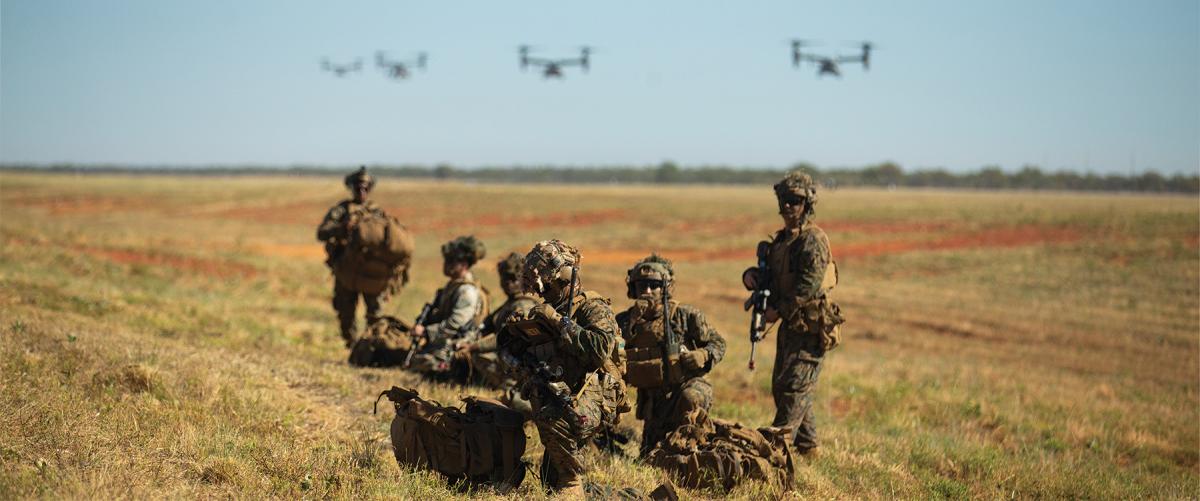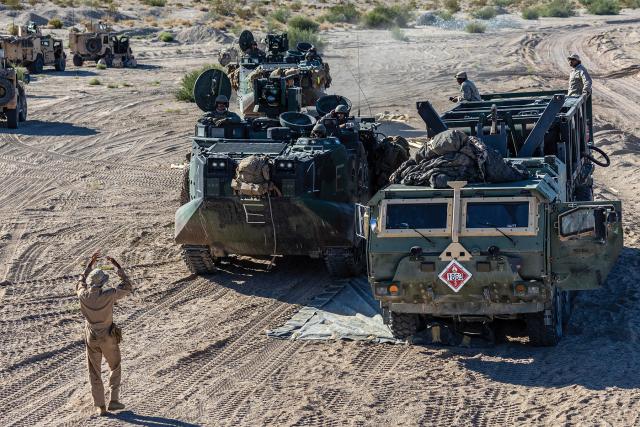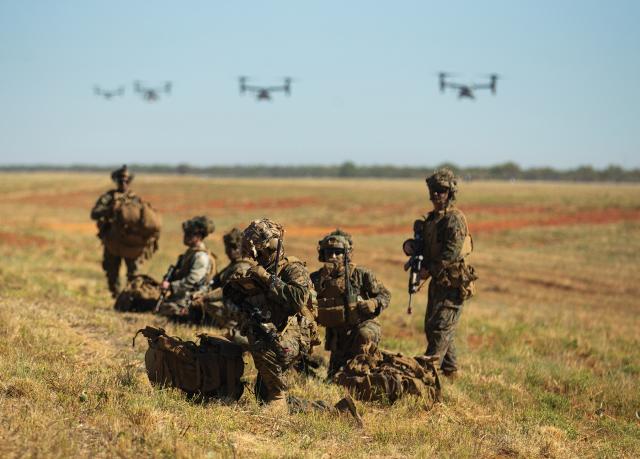Major Christopher Denzel, U.S. Marine Corps

The Marine Corps’ foundational doctrine, Marine Corps Doctrinal Publication (MCDP) 1: Warfighting, has had such a profound cultural impact on the service that any discussion of rewriting it is contentious. Rewritten it must be, however—not because it is wrong, but because it is framed in a way that confuses war’s character with its nature. The fundamental problem with MCDP-1’s conception of maneuver warfare is that a term for it already exists: operational art.
MCDP-1 was originally released in 1989, as Fleet Marine Force Manual 1: Warfighting. The maneuver warfare debates that preceded it had grappled with the failures of the Vietnam War, in which an apparently scientific way of war did not translate tactical success into strategic victory. Examining the same failures, the U.S. Army developed similar ideas into what is now known as operational art, which attempts to design and link tactical actions to achieve operational and strategic ends.
However, Warfighting was strongly informed by the often-inscrutable ideas of military theorist and Air Force veteran John Boyd, in particular the OODA loop—observe, orient, decide, act. Bill Lind, a controversial aide to Senators Robert Taft and Gary Hart, radically interpreted Boyd and zealously championed some of his ideas, expressed in maneuver warfare. The Marine Corps ended up with an emotionally charged doctrine that nevertheless appeared to offer a harmonized view of war. And that view allowed Marines to imagine operational approaches to defeat the enemy.
The Army, seized somewhat less by the emotion of the maneuver warfare debates of the 1980s, developed a less inspired but also less controversial body of thought in the language of operational art. This more steady-handed approach did not catch like wildfire in the same way as the Marine Corps’ maneuver warfare, but it slowly came to dominate the joint force’s thinking about how to approach warfare.
MCDP-1 esteems a single warfare method above all others. It makes maneuver the primary lens through which to understand warfare, which confuses the reader’s understanding of operational art. This ultimately leads many to misapprehend the nature of war, confusing it with the character of maneuver warfare.
It is possible to rehabilitate MCDP-1. But to do so will require the Marine Corps to bridge the increasingly apparent divide between what Marines believe about warfare and MCDP-1’s claims. Those who revise the publication will need to harmonize MCDP-1’s problematic claims about “maneuver warfare” with a coherent theory of warfare methodologies.

A Marine with 2d Marine Logistics Group guides an Assault Amphibious Vehicle at a mobile fuel station setup during an exercise on Camp Wilson, California, in August 2023. Operational art encompasses the art and science of logistics. U.S. Marine Corps (Christian Salazar)
On War(fare Methodology)
As construed by MCDP-1, maneuver warfare is definitionally flawed and does not fit in any internally consistent theory of war.1 Its construction creates a false dichotomy between attrition and maneuver. But the attention given to that dichotomy also masks a third method critical to modern operating concepts: positional warfare. Coherent definitions of these three methods—attrition, positional, and maneuver warfare—render MCDP-1’s maneuver warfare techniques what one author calls a “fantasy.”2
In the October 2022 Marine Corps Gazette, I borrowed from Army doctrine and military theorist Amos Fox to define those three methods by the defeat mechanisms they pursue, which helps resolve this false dichotomy. In this scheme, attritional techniques are “methods to reduce enemy capacity to fight.” Positional techniques are “methods to reduce enemy capability to fight.” Maneuver warfare techniques reduce the enemy’s “will to fight.”3 It is easiest to verify the achievements of attritional methods. It is hardest to do so for maneuver methods. At the same time, attrition’s success is the hardest to reverse, while the nebulous successes of maneuver are the easiest to reverse. Combined, the high verifiability and low reversibility make attritional techniques a more reliable way to achieve a desired end state.
Expanding this line of reasoning suggests how to make MCDP-1 more useful.
The Falsifiability of Warfare Methods
Falsifiable claims can be contradicted by experiment and challenged by measurable evidence. Done properly, such tests increase the likelihood that a given hypothesis is correct. If combat tests a theory of victory, then, for combat to prove it valid, any such theory should rely on defeat mechanisms that can be measured (and, therefore, falsified). Victory, however satisfying, is insufficient proof. Without reliably testing warfighting methods for this purpose, commanders depend mainly on gut instinct to win.
Army Chief Warrant Officer 5 Maurice Duclos asserts that the operational factors of time, space, and materiel are the only measurable factors in competition.4 Duclos developed this notion to help special operations forces focus on activities that measurably contribute to competition rather than those that merely brief well. The argument is simple: If you cannot articulate the measured impact of an activity, you should not make it a priority. If you estimated an operation’s measured effect but failed to achieve it, you should recalibrate or terminate the activity.
In Duclos’s formulation, the materiel factor corresponds to attritional methods. Gauging materiel and its destruction is the most straightforward measurement in war—burning tanks are easy to count. Time and space relate more to positional advantage and are more challenging to measure. They are interrelated in complex ways and vary based on combatant capabilities. Gaining advantage in time usually imposes costs in space, and vice versa.
A dedicated maneuverist might claim that achieving a time advantage—tempo—is a key element of maneuver warfare. This is a misapprehension. A time advantage principally enables a positional or attritional advantage: beating the adversary to key terrain or destroying critical materiel faster than it can be replaced. But time, in itself, has no meaning for combat.

Marines with Marine Rotational Force–Darwin 22 establish defensive positions as MV-22 Ospreys approach for landing during an airfield seizure event. It is alarming to realize that MCDP-1 does not consider the possibility that maneuver warfare could fail. Its implicit advice in the face of an unsuccessful approach is to maneuver harder. U.S. Marine Corps (Cedar Barnes)
The conflation of unrelated concepts (tempo) with maneuver warfare is another of MCDP-1’s flaws. Cognitively “out-cycling” the enemy’s OODA loop is a second-order result of the positional or attritional advantage gained by speed; the cognitive effect does not stem from the speed itself. When MCDP-1 makes this same point, it clarifies that it is relative speed that is important, but it leaves unstated what effect this speed should provide. In a dogfight, relative speed enables one pilot to act by shooting down the other. In this way, the “A” in OODA could well be “attrition.”
Unmeasurable methods of war are unscientific because they are untestable. Notably absent from Duclos’s list of measurable factors are will, morale, cohesion, and the other intangibles on which maneuver warfare relies. These intangibles are not unimportant—only unmeasurable by anything more than unreliable and distant proxies. Thus, any military approach based on these intangible factors is warfare waged on faith. It cannot be trained, planned, assessed, or changed.
This allows maneuverists to claim that any failure of maneuver warfare is simply a failure to do it correctly, while successful attrition warfare is somehow secretly maneuverist at its core. “A real maneuverist would have succeeded.” If the only way to tell a “real” maneuverist from a bad one is by judging success after the fact, the concept is unmeasurable and, therefore, unfalsifiable, because it depends primarily on changeable definitions. This logical fallacy is common enough to have a name: “No True Scotsman.”
Consider as an example MCDP-1’s claim that, using center-of-gravity analysis, targeted attrition will cause the enemy’s will to collapse. How can this be measured? By the outcome (surrender, perhaps)? This is no help, because high-value attrition was the only measurable action. Should a commander reveal that he surrendered because he foresaw this attrition outpacing his ability to replace or reconstitute forces, we would have only managed to verify the definition of attrition warfare. Measuring progress during a “maneuver warfare” battle or campaign is impossible because the decision to cease fighting is instantaneous (never mind reversible). This renders debates about maneuver warfare quixotic and exhausting, as the decade of “Attritionist Letters” and “Maneuverist Papers” series in the Marine Corps Gazette reveals.
MCDP-1’s preoccupation with maneuver warfare makes it a fragile doctrine based on a single, unfalsifiable theory of victory. Getting past the philosophy and down to the application, MCDP-1’s maneuver warfare becomes indistinguishable from the attrition warfare it abhors. Something is maneuver warfare if a maneuverist says it is, even though it might instead be characterized (fairly) as efficient attrition.
MCDP-1 enables this by incorrectly and incompletely defining warfare methods. The problem can be seen in the pointless debate over whether expeditionary advanced base operations (EABO) is consistent with maneuver warfare. Advocates insist it is. Force design opponents insist it is not. Marines can disagree over such a basic assessment only because MCDP-1’s incomplete and muddled conception of warfare methods is ambiguous at best. Meanwhile, the debate distracts from the critical question of whether EABO will work.
But if MCDP-1’s logic is so fragile, why haven’t Marines failed more often on the battlefield? Marines succeed tactically because what they actually employ are positional and attritional techniques—closing with and destroying the enemy. The fact that Marines do so and call it maneuver warfare is a problem of cognitive dissonance. While MCDP-1 may do a poor job describing operational art, its shared roots and similar approach make the publication broadly useful, nonetheless.
The Contours of a Rewrite
The present MCDP-1 confuses the nature of war with the character of a single warfare method. Worse, it implies that there is a single superior form of warfare for all contexts, which breaks the strategic linkage between ends, ways, and means. The Marine Corps needs to divorce “warfighting” from “maneuver warfare.”
The service also should banish the idea that the enemy’s will is directly targetable in operational approaches. However important intangibles are, the ability to factor them into training and war planning is vanishingly small. Consider that no historically executed U.S. war plan has ever successfully targeted the enemy’s will. And one can hardly train to affect the will of an adversary. Even in force-on-force exercises, with no genuine threat to life or liberty, there is no real opposing will to be broken.
Consider the following passage from MCDP-1:
One essential means to overcome friction is the will; we prevail over friction through persistent strength of mind and spirit. While striving ourselves to overcome the effects of friction, we must attempt at the same time to raise our enemy’s friction to a level that weakens their ability to fight.5
This essentially exhorts Marines to will their way through friction. Worse, it implies the adversary lacks a reciprocal ability, presuming instead that he is inherently inferior—a shocking implication. MCDP-1 walks back this bold assumption in its next paragraph, where it helpfully counsels using training and experience—not will—to overcome friction. But the role of will in MCDP-1 continues to loom large.
In addition, the Marine Corps must describe “falsifiable” theories of victory and articulate defeat mechanisms that would illuminate the advantages, disadvantages, and relevance of each. This would encourage adaptation on the battlefield and allow commanders to develop reliable operational approaches to problems. It is alarming to realize that MCDP-1 does not consider the possibility that maneuver warfare could fail. Its implicit advice in the face of an unsuccessful approach is to maneuver harder.
Describing more than one way to fight might remove some of the zealotry that buries discussions of EABO’s effectiveness under the orthodoxy of maneuver warfare. The implicit presumption that anything Marines do must be “maneuver warfare” is anti-intellectual claptrap. This is warfighting, not the Spanish Inquisition.
While the principles of warfighting should apply in all domains, it is impossible to read MCDP-1 without realizing it is a two-domain doctrine—air and land. It is regrettable that the maritime domain receives scant mention. And one can argue that information and cyber operations may more directly affect adversary will than action in the physical domains. Yet both domains are absent—a sign of the publication’s age.
Moving away from two-domain warfare would better situate the Marine Corps within the joint force (which MCDP-1 fails to meaningfully do). Written in 1989, before even the First Gulf War, MCDP-1 is a post-Goldwater-Nichols document written with pre-Goldwater-Nichols thinking about the role of the service. And while MCDP-1 is service—not joint—doctrine, nearly four decades on from the establishment of the modern joint force, the Marine Corps deserves a foundational publication that envisions the service in a joint fight, especially now that joint fires and enablers are accessible at the lowest echelons.
Finally—and this will be most traumatic—erase the term “maneuver warfare” from the publication. If attritional and positional warfare are scientific and measurable methods of war and maneuver warfare is merely creativity in their application, then the appropriate term is operational art. The slow replacement of “maneuver warfare” with “operational art” outside the Marine Corps since the 1980s should be a hint. But the revulsion nearly all Marines might feel toward abolishing the maneuver warfare expression from doctrine is the clearest proof that the current edition of MCDP-1 has conditioned us to approach warfare with emotion, not professional detachment.
Science and Art
MCDP-1’s current form is flawed because of its overemphasis on an unscientific way of war and its blindness to a critical method: positional warfare. MCDP-1’s role in socializing new Marines into a warfighting ethos must be retained in any rewrite. But unless it is rewritten, other elements of MCDP-1 will continue to dilute intellectual debate, restrict innovative thinking about future conflicts, and reduce “maneuver warfare” into a shibboleth empty of practical meaning.
Some worry that rewriting MCDP-1 might ruin it. John Schmitt, its author, has likened writing MCDP-1 to catching lightning in a bottle—an event unlikely to happen again and impossible to try to replicate. But if Marines do not actually employ the maneuver warfare envisioned by MCDP-1, there is no harm in ruining it. The Marine Corps might end up with a more usable doctrine that Marines feel less emotional over. Wouldn’t that be a good thing?
No comments:
Post a Comment